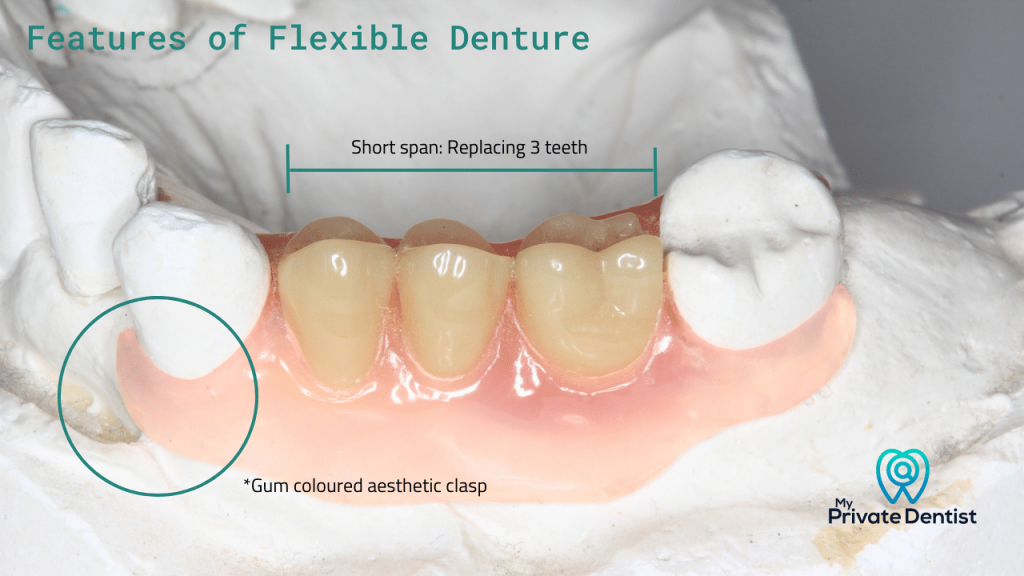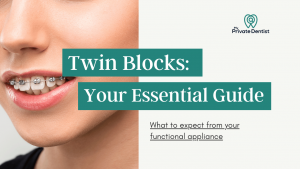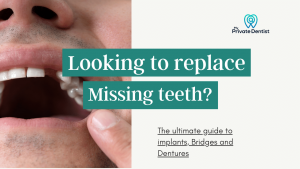Considering flexible dentures to replace missing teeth? Flexible dentures are a bendable, less rigid alternative to traditional acrylic partial dentures. They are usually smaller and less bulky, and are particularly useful to replace 1-3 missing teeth grouped together. Small gum coloured clasps help to keep them secure.
Dentures provide a great option for replacing teeth to restore your smile, improve your ability to eat and speak, and boost your self-confidence. However, traditional acrylic dentures have some drawbacks, such as their rigidity, bulkiness, and tendency to slip or fall out of place. This is where flexible dentures come in, as they offer a more comfortable and natural-looking alternative. As a dentist, I discuss flexible dentures as an important treatment option when deciding the best replacement for a missing tooth.
Removable flexible dentures are an increasingly popular option for replacing teeth, offering many advantages to alternatives; but are they long lasting and durable? Find out more.
What are flexible dentures?
Flexible dentures are a type of partial denture that can be easily removed from the mouth. Unlike traditional dentures, which are made of rigid acrylic, flexible dentures are made of a thermoplastic nylon material that is both lightweight and bendable. When placed in hot water, they can be moulded to fit securely in the mouth.
One of the benefits of flexible dentures is that they are made from a thinner and less bulky material than acrylic dentures. This makes them a more comfortable option for some patients who may find traditional dentures too heavy or uncomfortable.
Another advantage is that flexible dentures do not have any metal clasps. Instead, they have small clasps that are gum coloured that ‘hug’ the margins of surrounding teeth. These clasps help to keep the denture securely in place without being noticeable.
Valplast is a popular brand of flexible dentures, known for their high-quality materials and comfortable fit. With their clear, virtually invisible design and comfortable feel, flexible dentures are a great option for patients looking for a more natural-looking and comfortable denture solution.
Flexible dentures vs acrylic partial dentures: Which is better?
When it comes to choosing between flexible dentures and acrylic partial dentures, there is no clear winner. They are both used in cases where patients have missing teeth, where span is too large or unsuitable for a bridge or implant.
Ultimately, the choice between flexible dentures and acrylic partial dentures will depend on individual case selection, patient preference, and dentist recommendation. It’s important to weigh the advantages and disadvantages of each option before making a decision.
Advantages of flexible dentures
Flexible dentures are smaller and thinner than acrylic dentures, which is suited to patients with a prominent gag reflex or limited opening.
Due to their small gum coloured clasps to help secure them, flexible dentures can be made to replace 1-3 teeth in a short span, without needing to extend over your palate for retention. Acrylic dentures however, tend to be much larger and cover the palate to help keep them in place.
Flexible dentures can ‘flex’ into undercuts of teeth and gums for a better fit. This is particularly beneficial for patients with very tilted teeth, or prominent/irregular bony prominences. These patients may have struggled to wear traditional acrylic dentures in the past.
Flexible dentures are plastic and BPA free, which is good for patients that may have allergy.
They are aesthetic. Their translucent material makes them appear more natural. They also don’t have metal clasps or components as used in acrylic partial dentures to help keep them in place. They are stain resistant, and odour resistant.
They are less rigid, and have some give: When placed in warm water, they become softer and can be moulded into position. For this reason, patients find them more comfortable, and are less likely to get high spots that rub on gum and cause sores/ulcers.
They can be quicker to make; less stages typically
There are less chance of impact fractures from dropping flexible dentures, compared to acrylic dentures.
They are cheaper than alternatives of tooth replacement, such as implants.
Disadvantages of flexible dentures
Flexible dentures tend to be more expensive than acrylic dentures.
Not all dentists offer flexible dentures.
Although it is possible to make adjustments or additions to valplast flexible dentures if necessary: they are more difficult to adjust than acrylic dentures.
Flexible dentures are more prone to plaque build up. If you have gum disease, or a history of poor denture hygiene, may be less suitable.
Flexible dentures may not be suitable in a large span if you have a strong bite or you grind. They don’t have the bite strength of implant supported denture.
The colour of the flexible denture material may fade or degrade over time,
They are less durable than acrylic or chrome partial dentures, and may need replacing sooner.
Who is a good candidate for flexible dentures?
Flexible dentures are a versatile option, suitable for many patients that are missing some teeth. They could be used as a discreet temporary before considering other fixed options.
Flexible dentures can be a good option for patients who have some missing teeth but not all, particularly if they have several missing teeth in a row. They are also a good option for patients who have difficulty wearing traditional acrylic dentures due to discomfort or strong gag reflex. Additionally, flexible dentures are a good option for patients with allergies to metal or acrylic.
However, flexible dentures may not be suitable for patients who have all of their teeth missing and require a complete denture, as the material is not as load-bearing as acrylic dentures. They may also not be suitable for patients with missing teeth at the back of their mouth.
An ideal candidate for a flexible denture will have a span of 1-3 missing teeth on one side, with a space too large for a fixed bridge to predictably replace it

The best way to determine if you are a good candidate for flexible dentures is to consult with your dentist. They can evaluate your individual case and make a recommendation on the best treatment options for your specific needs.
How do you look after flexible dentures?
In order to properly care for and maintain your flexible denture, follow these steps.
Daily cleaning:
Wash the denture in the morning, at night and after meals. Clean flexible dentures under cool running water. Avoid very hot water as this can cause them to warp or lose their shape, which may affect their fit and function.
Use a denture brush to remove build up/food debris. Denture brushes are softer and less abrasive than a regular toothbrush.
Storage:
Take flexible dentures out at night before bed, and soak them in water in a small container. Don’t allow them to dry out as they can warp and no longer fit well.
Avoid using harsh chemicals or abrasive cleaners on your flexible dentures, as this can damage the material and cause it to degrade over time. Instead, use a mild cleaning solution that is specifically designed for use with flexible dentures, such as Val Clean [1].
Regular check ups:
Maintain regular dental check ups to ensure denture function and longevity. Valplast flexible dentures come with a lifetime guarantee.
How much do flexible dentures cost?
The cost of flexible dentures can vary widely depending ithe complexity of the case, the type of flexible denture material used, and the location of the dental practice. In general, flexible dentures may cost more than traditional acrylic dentures, but less than other options like dental implants or fixed bridges.
On average, the cost of flexible dentures in the UK can range from £400 to £2,000 or more per arch (upper or lower jaw), with an average cost of around £1,000 per arch.
It is important to note that this is just an estimate and that prices can vary significantly depending on the factors mentioned above.
They are not usually offered under the NHS.
Some dental insurance plans may cover a portion of the cost of flexible dentures, so patients should check with their provider to determine their coverage options. Ultimately, the best way to get an accurate estimate of the cost of flexible dentures is to have a consultation with a dentist who can evaluate your individual case and provide a personalised treatment plan and cost estimate.
Can you have full flexible dentures?
Full flexible dentures are not commonly offered as a suitable option to replace all missing teeth. As dentures are bendable, they are not as strong as acrylic or chrome dentures, and more likely to break under pressure.
Flexible dentures are more suitable as a partial denture.
How are flexible dentures made?
1.Consultation: Your dentist will consider your concerns about missin teeth, and discuss different removable and fixed replacement options
2.Impressions: If you decide on a flexible denture, and impression will be taken of your teeth. Moulds are usually taken in alginate, a runny material loaded into trays, that sets hard in your mouth after a couple minutes. If you have a prominent gag reflex, this may cause some discomfort
3.Evaluate shade: Specifics of tooth and gum shade are evaluated, and agreed by patient
4.Lab stage: Moulds and a record of how you bite are sent to a lab, for construction of a ‘try in’ denture.
5.Try in: A ‘try in’ denture is made in wax, and gives you an idea of how your finished denture will look and fit. Adjustments of bite or shade can be made at this stage. The lab will detail any undercuts that clasps can engage to prevent your flexible denture from coming loose
6.Finished denture: If you’re satisfied with your try in, the denture will be completed. It can be heated under running warm water to make denture more mouldable to fit . As it cools down when placed, it regains more rigidity.
7.Review and adjustments: Any high spots or tight areas can be relieved, and denture is polished. The dentist will ensure that you’re able to wear your flexible denture comfortably, with good fit, function and aesthetics.
8. Care advice: The dentist will provide instructions on how to care for and maintain your flexible denture, including regular check-ups and cleanings.
How else could I replace missing teeth?
If you have missing teeth and you’re considering replacement options, there are several options to choose from.
If the missing teeth are in a non-aesthetic zone, and you have plenty of healthy teeth for eating comfortably, you may choose not to replace them and accept the space. This is usually an acceptable option, though teeth are at risk of over-erupting or drifting if unopposed.
Removable options for replacing teeth include dentures. They are taken out at night and worn during the day for aesthetics and function. There are two types of removable dentures: partial/complete acrylic dentures and partial/complete cobalt chrome dentures. The price variation is due to factors such as the dentist’s experience, clinic location, and expertise of the lab. Cobalt chrome dentures tend to be more expensive than acrylic dentures due to the construction of the metal component and added lab stages. They are good for patients with heavy bites that may have broken through acrylic dentures in the past.
Bridges are a fixed option for replacing teeth. Conventional bridges require the preparation of teeth next door, and so are destructive to teeth tissue. Resin-retained bridges, however, require minimal or no preparation of teeth and are cemented into position with a strong resin cement. Although they are excellent with correct case selection, they are not suitable for every patient and depend on tooth position. They are also not suitable for replacing multiple missing teeth.
Implants are the closest option to natural teeth. They require surgery, with a screw implanted into your jawbone. A detailed assessment is required to assess suitability, and they are not suitable for patients with gum disease or smokers. Implants are the most expensive option and are not offered by every dentist.
What should I do now?
Flexible dentures certainly have their advantages, as a thin discreet option for replacing teeth. Their mouldable nature makes them more comfortable and compact for some patients, as they can slot in to gaps without needing extension on to the roof of the mouth to make them retentive.
If you have missing teeth and want to consider your options, find a dentist today to discuss flexible dentures and find out if they are a good fit for you.



